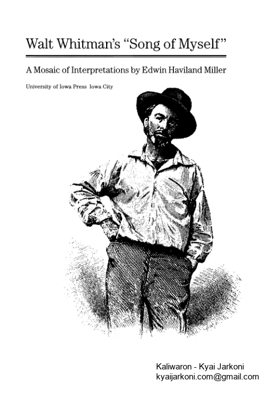wrestled with “Song of Myself” as much perhaps for my own enlightenment as reader-lover, who is purged of pretense and negativity, to catch up and join.
209 pages
155 KB – 209 Pages
PAGE – 4 ============
University of Iowa Press, Iowa City 52242 Copyright © 1989 by the University of Iowa All rights reserved Printed in the United States of America First paperback printing, 1991 Design by Richard Hendel Typesetting by G&S Typesetters, Austin, Texas Printing and binding by Malloy Lithographing, Ann Arbor, Michigan No part of this book may be reproduced or utilized in any form or by any means, electronic or mechanical, including photocopying and recording, without permission in writing from the publisher. Library of Congress Cataloging-in-Publication Data Miller, Edwin Haviland. [Song of myself] Walt Whitman’s “song of myself”: a mosaic of interpretations/by Edwin Haviland Miller. p. em. Bibliography: p. Includes index. ISBN 0-87745-227-X, ISBN 0-87745-345-4 (pbk.) 1. Whitman, Walt, 1819-1892. Song of myself. I. Title. PS3222.S63M55 1989 88-38069 811′.3-dc19 CIP
PAGE – 9 ============
Preface I undertook the preparation of what I call “A Mosaic of Interpretations” for two reasons. For more than twenty-five years in print and in the classroom I have wrestled with “Song of Myself” as much perhaps for my own enlightenment as my readers’ or students’. I have also had for some time deep reservations as to the adequacy of any single approach, regardless of its breadth or depth, in flecting the resonances and meanings of one of the most difficult and exciting poems in our literature. Second, I think readers and students need assistance, a guide as it were, in coping with a commentary that I estimate now runs to thousands of pages. Four Whitman scholars read and commented on the manuscript in early stages, and I have profited from their guidance in a number of ways. I am glad to knowledge publicly my indebtedness to Harold Aspiz, Ed Folsom, Arthur Golden, and Jerome Loving. They are not responsible, I quickly add, for errors in ment, omissions, or the final organization of the “Mosaic.” I also want to record my appreciation of the assistance of librarians at the New York University brary and the New York Public Library and of the aid of Ivan Marki and Kenneth Price. Finally, I want to recognize the usefulness and stimulation of two prior studies: Gay Wilson Allen’s Walt Whitman Handbook (1946) and James E. Miller Jr.’s Whitman’s “Song of Myself”-Origin, Growth, Meaning (1964). As for my debt to my wife, Rosalind, I still after forty-two years have not found the appropriate words.
PAGE – 11 ============
Introduction In July 1855, about the time Americans were again celebrating their dence, an oversized book with the strange title Leaves of Grass was published in Brooklyn. The embossed, gayly decorated letters of the title seem almost to dance across the green cover. Neither on the cover nor on the title page is the author identified, an omission not unusual in an era when many books appeared mously. What is unusual is the frontispiece, an engraving based on a type, of an unidentified workingman with a straw hat perched foppishly on his forehead, an exposed undershirt, said to have been red, and, paradoxically, the eyes of a seemingly detached dreamer I observer. The copyright in the name of Walter Whitman appears on the verso of the title page. The author is not named until about the middle of the first poem, on page twenty-nine, to be exact, in one of the most grandiose and immodest lines in literature-“Walt Whitman, an American, one of the roughs, a kosmos.” Early readers, of whom there were but a few, could not recognize the cance of the line. At age thirty-six a man previously known publicly as Walter Whitman during a career that included employment in printing shops, on papers as reporter and editor in Brooklyn, briefly in schools on Long Island, tized himself Walt Whitman and soon was to establish a first-name relationship with his audience. The book of twelve poems without titles was a more personal creation than anyone could have imagined. Even its production in almost every detail was closely supervised by the author: he set part of the type himself and designed the cover. The color and the title introduce one of the symbols of his poetry, grass, and the dancing letters evoke the kosmic (to use his spelling) choreography and the universal “procreant urge,” which in turn will be part of a democratic raphy created by a perceptive observer-and lover-of the heterogeneous, classless American society. In Section Seven he commands, “Undrape,” but earlier in Section Two he sents himself “undisguised and naked,” and promptly proceeds to undrape self as he itemizes with loving care and imaginative verbiage bodily parts usually draped anatomically and always verbally in a freewheeling republic seemingly without genitals-“neuter” is Whitman’s word for the collective castration or fear. Not only does the poet shed his clothes but he also seeks with unconcealed seductiveness a personal and erotic bond with each reader. His book, while physically a collection of twelve poems, is in a sense a person about to engage in a kind of dialogue with you the reader. “Gentle Readers” had been courted since the invention of the printing press, but usually within the parameters of genteel
155 KB – 209 Pages
